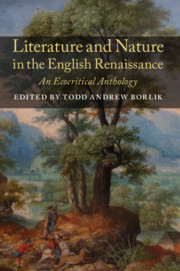Book contents
- Frontmatter
- Contents
- List of Illustrations
- Acknowledgements
- Editorial Principles: Towards the Ecocritical Editing of Renaissance Texts
- Introduction
- PART I Cosmologies
- PART II The Tangled Chain
- PART III Time and Place
- Seasons
- Country Houses
- Gardens
- Pastoral: Pastures, Meadows, Plains, Downs
- Georgic: Fields, Farms
- Forests, Woods, Parks
- Heaths, Moors
- Mountains, Hills, Vales
- Lakes, Rivers, Oceans
- PART IV Interactions
- PART V Environmental Problems in Early Modern England
- PART VI Disaster and Resilience in the Little Ice Age
- Appendix A Industrialization and Environmental Legislation in the Early Anthropocene: A Timeline
- Appendix B Further Reading: A Bibliography of Environmental Scholarship on the English Renaissance
Forests, Woods, Parks
from PART III - Time and Place
Published online by Cambridge University Press: 05 June 2019
- Frontmatter
- Contents
- List of Illustrations
- Acknowledgements
- Editorial Principles: Towards the Ecocritical Editing of Renaissance Texts
- Introduction
- PART I Cosmologies
- PART II The Tangled Chain
- PART III Time and Place
- Seasons
- Country Houses
- Gardens
- Pastoral: Pastures, Meadows, Plains, Downs
- Georgic: Fields, Farms
- Forests, Woods, Parks
- Heaths, Moors
- Mountains, Hills, Vales
- Lakes, Rivers, Oceans
- PART IV Interactions
- PART V Environmental Problems in Early Modern England
- PART VI Disaster and Resilience in the Little Ice Age
- Appendix A Industrialization and Environmental Legislation in the Early Anthropocene: A Timeline
- Appendix B Further Reading: A Bibliography of Environmental Scholarship on the English Renaissance
Summary
Unlike parks today, Tudor parks were restricted spaces – owned by the king, nobles, or gentry – and reserved for keeping deer and other game. As England's population exploded in the sixteenth century, some persons began to feel that too much of the nation's land was set aside by the wealthy for private hunting grounds. In his Perambulation of Kent (1576), William Lambarde estimated that half of the county's parks had been disparked “within memory.” The high point probably occurred in the 1540s. Disparking slowed considerably during Elizabeth's reign (Pitmann), a trend that Harrison here seeks to reverse.
Source: Holinshed's Chronicles (1587), 204–5.
In every shire of England there is great plenty of parks, whereof some … (well near to the number of two hundred) [are] for [the] daily provision of that flesh appertaining to the prince; the rest to such of the nobility and gentlemen as have their lands and patrimonies lying in or near unto the same. I would gladly have set down the just number of these enclosures to be found in every county. But since I cannot so do, it shall suffice to say that in Kent and Essex only are to the number of one hundred, and twenty in the bishopric of Durham, wherein great plenty of fallow deer is cherished and kept. As for warrens of conies, I judge them almost innumerable, and daily like to increase by reason that the black skins of those beasts are thought to countervail the prices of their naked carcases, and this is the only cause why the grey are less esteemed …
Our parks are generally enclosed with [a] strong pale made of oak, of which kind of wood there is great store cherished in the woodland countries from time to time in each of them, only for the maintenance of the said defence and safekeeping of the fallow deer from ranging about the country. Howbeit, in times past diverse have been fenced in with stone wall, especially in the times of the Romans, who first brought fallow deer into this land (as some conjecture), albeit those enclosures were overthrown again by the Saxons and Danes …
- Type
- Chapter
- Information
- Literature and Nature in the English RenaissanceAn Ecocritical Anthology, pp. 265 - 285Publisher: Cambridge University PressPrint publication year: 2019



